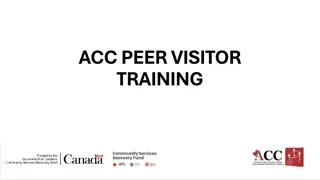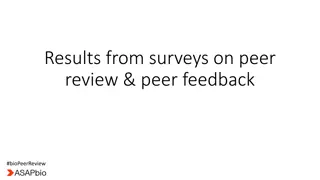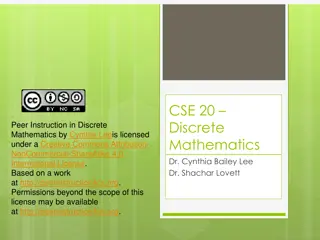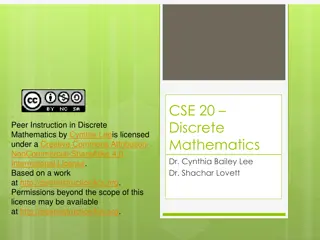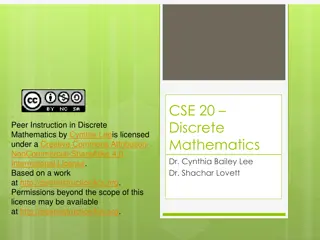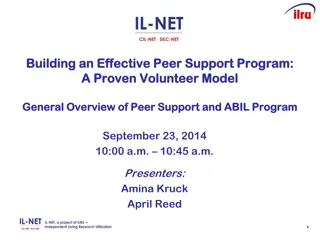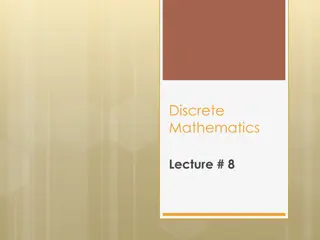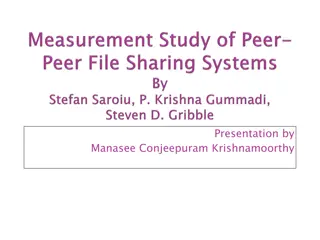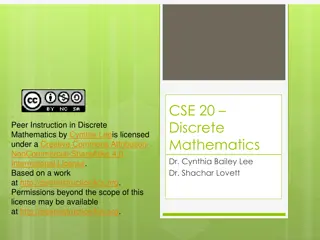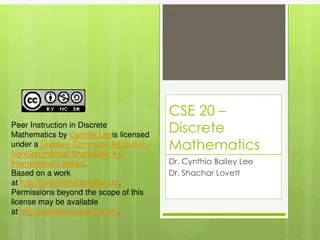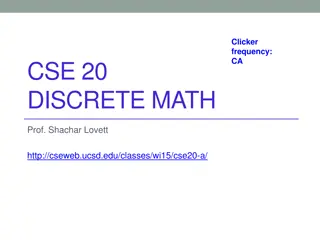Peer Instruction in Discrete Mathematics
Topics on relations and equivalence relations in discrete mathematics through engaging peer instruction sessions. Understand the concepts of symmetry, reflexivity, and transitivity in relation graphs with interactive visuals and theorems. Dive into the fundamentals of discrete mathematics with Dr. Cynthia Bailey Lee and Dr. Shachar Lovett.
Download Presentation

Please find below an Image/Link to download the presentation.
The content on the website is provided AS IS for your information and personal use only. It may not be sold, licensed, or shared on other websites without obtaining consent from the author.If you encounter any issues during the download, it is possible that the publisher has removed the file from their server.
You are allowed to download the files provided on this website for personal or commercial use, subject to the condition that they are used lawfully. All files are the property of their respective owners.
The content on the website is provided AS IS for your information and personal use only. It may not be sold, licensed, or shared on other websites without obtaining consent from the author.
E N D
Presentation Transcript
Creative Commons License CSE 20 Discrete Mathematics Dr. Cynthia Bailey Lee Dr. Shachar Lovett Peer Instruction in Discrete Mathematics by Cynthia Leeis licensed under a Creative Commons Attribution- NonCommercial-ShareAlike 4.0 International License. Based on a work at http://peerinstruction4cs.org. Permissions beyond the scope of this license may be available at http://peerinstruction4cs.org.
2 Today s Topics: 1. Relations 2. Equivalence relations
3 1. Relations
4 Relations are graphs Think of relations as graphs xRy means there in an edge x y Is A. R ? B. R ? C. Both D. Neither
5 Relations are graphs What does this relation capture? xRy means 2 3 A. x>y B. x=y C. x divides y D. x+y E. None/more than one 1 4 6 5
6 Types of relations A relation is symmetric if xRy yRx. That is, if the graph is undirected Which of the following is symmetric A. x<y B. C. x and y have the same sign D. x y E. None/more than one x divides y
7 Types of relations A relation is reflexive if xRx is true for all x That is, the graph has loops in all vertices Which of the following is reflexive A. x<y B. C. x and y have the same sign D. x y E. None/more than one x divides y
8 Types of relations A relation is transitive if xRy yRz xRz This is less intuitive will show equivalent criteria soon Which of the following is transitive A. x<y B. C. x and y have the same sign D. x y E. None/more than one x divides y
9 Types of relations A relation is transitive if xRy yRz xRz Theorem: Let G be the graph corresponding to a relation R. R is transitive iff whenever you can reach from x to y in G then the edge x y is in G. Try to prove yourself first
10 Types of relations Theorem: R is transitive iff when you can reach from x to y in G then the edge x y is also in G. Proof (sufficient): Assume the graph G has this property. We will show R is transitive. Let x,y,z be such that xRy and yRz hold. In the graph G we can reach from x to z via the path x y z. So by assumption on G x z is also an edge in G. Hence xRz so R is transitive.
11 Types of relations Theorem: R is transitive iff when you can reach from x to y in G then the edge x y is also in G. Proof (necessary) by contradiction: Assume by contradiction R is transitive but G doesn t have this property. So, there are vertices x,y with a path x v1 vk y in G but where there is no edge x y. Choose such a pair x,y with minimal path length k. We divide the proof to cases. Case 1: k=0. So x y in G. Contradiction. Case 2: k=1. Since R is transitive then x v1 and v1 y imply x y. Contradiction. Case 3: k>1. Then x vk must be in G since the path has length k-1 and we assumed the path from x to y is of minimal length. So in fact x vk y. Contradiction. QED
12 2. Equivalence relations
13 Equivalence relations Definition: a relation is an equivalence relation if it is Reflexive Symmetric Transitive What does that actually means???
14 Equivalence relations Best to explain by example In the universe of people, xRy if x,y have the same birthday Relfexive: xRx Symmetric: xRy implies yRx Transitive: if x,y have the same birthday, and y,z have the same birthday, then so do x,z.
15 Equivalence relations An equivalence relation partitions the universe to equivalence classes E.g. all people who were born on 1/1/2011 is one equivalence class Reflexive: a person has the same birthday as himself dahhh . Symmetric: if x,y have the same birthday then so do y,x Transitive: if x,y have the same birthday, and y,z have the same birthday, then so do x,z
16 Equivalence relations As a graph
17 Equivalence relations As a graph Equivalence classes
18 Equivalence relations Which of the following is an equivalence relation in the universe of integer numbers A. x divides y B. x*y>0 C. x+y>0 D. x+y is even E. None/more than one/other
19 Equivalence relations Which of the following is an equivalence relation in the universe of graphs A. x,y have the same number of vertices B. x,y have the same edges C. x,y are both Eulerian D. x,y are the same up to re-labeling the vertices (isomorhpic) E. None/more than one/other
20 Equivalence relations as functions We can see an equivalence relation as a function Universe Property E.g. People Integers Graphs birthday sign #vertices An equivalence class is the set of elements mapped to the same value
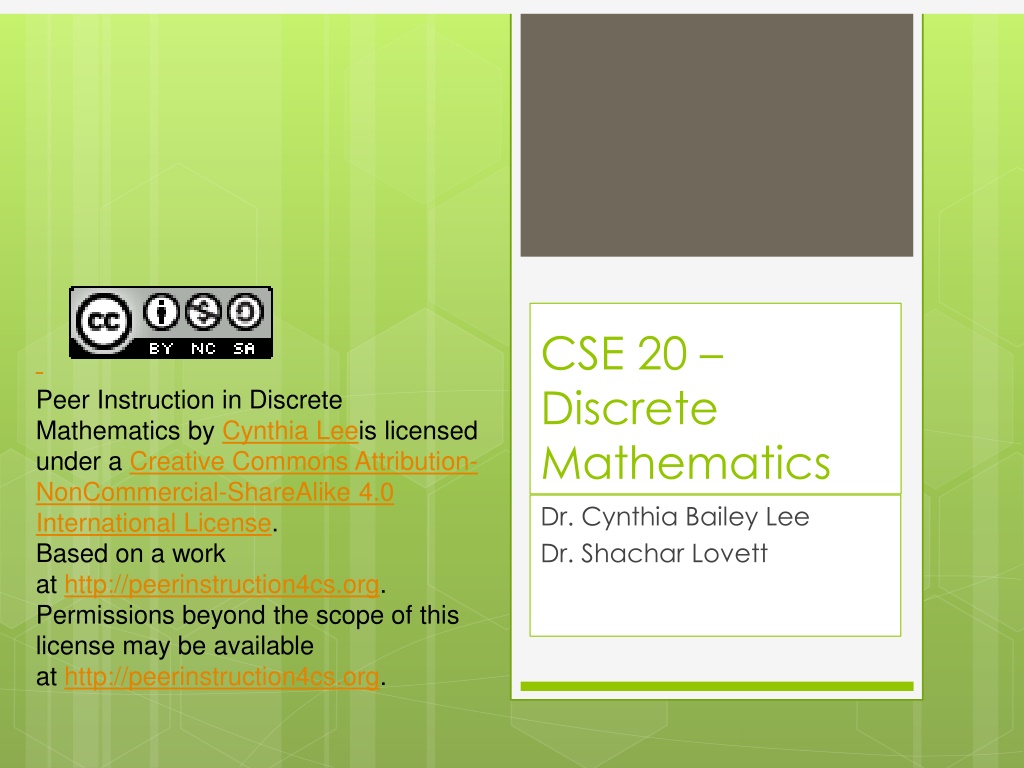
 undefined
undefined














